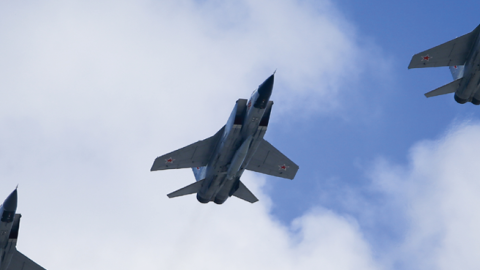This Brief provides a comprehensive, if necessarily preliminary, review of the Weapons of Mass Destruction (WMD) issues that have arisen due to Russia’s aggression against Ukraine since 24 February 2022. These issues include Russian threats to use nuclear weapons against Ukraine and its Western partners, Russia’s employment of hypersonic missiles, Russia’s harmful activities regarding Ukraine’s civilian nuclear power plants, and Russia’s false accusations against Ukraine and its Western partners concerning chemical and biological weapons and laboratories. Many Russian actions – such as attacking civilian nuclear power plants or employing hypersonic missiles–have set precedents with potentially
immeasurable future consequences.
Especially at the onset of the invasion, Russian leaders threatened to use nuclear weapons due to Ukraine-related developments. In announcing the attack, Putin warned countries thinking of intervening militarily on Ukraine’s behalf that they would face “consequences … such as you have never seen in your entire history.”1 Shortly after launching the invasion, Putin ordered that Russia’s strategic forces assume “special combat duty,” which the US intelligence community believes means taking “heightened preparations designed to ensure a quick transition to higher alert status” if warranted.2 Two months later, Russian Foreign Minister Sergei Lavrov highlighted the risk of nuclear war through foreign intervention.3 Other Russian officials similarly said that Western restraint regarding Ukraine would decrease the potential for nuclear war with Russia.4
The frequency of Russian nuclear threats has generally declined during the war. A possible reason is that Western governments have made clear their reluctance to intervene directly with their own combat forces. Instead, they have limited their response to imposing economic sanctions on Russia while rendering military training, weapon deliveries, and diplomatic backing to Ukraine. Still, on 25 June, Putin announced that Russia would help upgrade Belarus’ Su-25 fighter bombers to carry nuclear bombs, and train Belarus to operate them, and Russia intends to provide that country with Iskander-M missiles, which can deliver nuclear as well as conventional warheads.5 Putin’s statement follows the removal earlier this year of an article in Belarus’ constitution affirming the country’s “nuclear-free” status.6
Even so, many foreign observers consider threats of Russian nuclear weapons use during the Ukraine War credible if extremely unlikely. UN Secretary-General António Guterres has observed, “The prospect of nuclear conflict, once unthinkable, is now back within the realm of possibility.”7 When he testified before Congress in April, CIA Director William Burns cautioned that US policymakers must take the threat of Russian use of non-strategic (aka tactical) nuclear weapons seriously.8 The US military has elevated its monitoring of Russian activities and prepared for nuclear use contingencies.9 Fears of escalation have also resonated among an anxious European public, with respondents alarmed both by the explicit Russian threats and the mere fact that Russia has nuclear weapons.10
The war will likely further decrease the prospects for nuclear arms control and increase the incentives for further nuclear proliferation. Former Russian President Dmitry Medvedev explicitly stated that the strong US support for Ukraine has ruined near-term opportunities for bilateral nuclear arms control.11 Influential Ukrainians and others consider Ukraine’s renunciation of nuclear weapons upon independence in exchange for international security assurances to have been a mistake. Though Russian statements regarding the undesirability of nuclear weapons proliferation continue, Russian policies towards the nuclear activities of Iran and North Korea have recently softened. For example, Russia has declined to support further sanctions on either country at the United Nations despite both states violating earlier UN resolutions constraining their nuclear-related activities. As a result, Russia’s aggression regarding Ukraine has potentially both directly incentivised other countries to seek nuclear arsenals and indirectly removed disincentives for their doing so.
Hypersonics
One reason the Ukraine conflict is unique is that it marks the first use of hypersonic delivery systems in wartime. Since the war began, Russia has launched approximately a dozen hypersonic Kh-47M2 Kinzhal ‘Dagger’ Air-Launched Ballistic Missiles against Ukrainian territory.12 The Kinzhal is essentially a faster, air-launched version of Russia’s ground-launched Iskander missile. It lacks the manoeuvrability of the more advanced hypersonic glide vehicles or hypersonic cruise missiles, but flies sufficiently fast (at least five times the speed of sound) to be defined as a hypersonic missile.13
The main tactical reasons that Russia has employed these missiles have been their difficulty of interception, their ability to obliterate certain hardened targets with less collateral damage than other weapons, and their underscoring Russia’s escalation dominance over Ukraine. Ukrainian air defences have been able to shoot down many of Russia’s slower flying cruise and ballistic missiles, but have proven unable to intercept the faster hypersonic missiles. The main strategic reasons for Russia’s use of these systems are to make Ukrainians understand that the Russian military can hit any target in Ukraine with only a few minutes’ notice, to validate the technology (using Ukraine as a testbed), to highlight Russia’s lead in operationalising these weapons, and to communicate warnings to Western countries about the risks of providing military assistance to Ukraine against Russia.
That said, Russia has only a limited number of these missiles, so they have been employed selectively. Almost all the almost two thousand missiles that the Russian armed forces have launched against Ukraine have been subsonic or supersonic cruise and ballistic missiles, supplemented by unguided bombs dropped by Russian warplanes. Hypersonic vehicles have represented only a small proportion of the total number of missiles in the Russian bombardment of Ukraine. Additionally, Russia has delivered some of these missiles against arguably marginal targets, such as a shopping mall in Odesa, suggesting poor targeting intelligence and other inaccuracies.14 These factors led the US Joint Chiefs of Staff Chairman, General Mark Milley, to tell the Congress in May that Russia’s employment of hypersonic missiles in Ukraine has not had “significant or game-changing effects” during the conflict.15
Threats to Civilian Nuclear Facilities
The Russia-Ukraine war has also been unprecedented in that some battles have occurred near operating nuclear power stations. Ukraine’s four large plants operate 15 nuclear reactors, which generate approximately half of the country’s electricity. International attention initially focused on the Russian military’s seizure of the Chornobyl Nuclear Power Plant, infamous for the 1986 explosion that spewed radioactivity across Europe, as its forces were advancing south from Belarus. During their five weeks of occupation, Russian troops violated established rules of nuclear safety and security by holding the plant’s staff hostage, refusing to allow for their orderly rotation, digging trenches in radioactive soil, and looting the plant’s equipment.16
The Russian decision to conduct offensive operations near the Zaporizhzhya Nuclear Power Plant, the largest such facility in Europe, was arguably more dangerous. The six reactors there have been designed to avoid a Chornobyl-style meltdown and thwart terrorist terrorists and insider sabotage attempts, but the possibility of their coming under bombardment by modern heavy weapons was not considered. If their cooling system or other critical components are disrupted, they could explode or release radioactive material into nearby rivers. Since assaulting the Zaporizhzhya plant in early March, the Russian forces, while keeping the Ukrainian staff operating the facility, have converted the plant into a small base with hundreds of troops and military equipment such as tanks.17 The Ukrainian forces have thus far avoided attacking the base, partly for fear of triggering a nuclear catastrophe. The Ukrainian authorities have called on the international community to resolve this threat, but Russia has denied the repeated requests of the Director of the International Atomic Energy Agency, Rafael Mariano Grossi, that Agency personnel conduct a physical inspection at the site.18 The Russian military attacks also damaged a nuclear waste disposal facility near Kyiv and a nuclear research institute in Kharkiv.19 A continuation of the fighting could see additional damage to Ukraine’s nuclear facilities. Not without reason, Guterres has insisted, “the security and safety of nuclear facilities must also be preserved.”20
Chemical and Biological Threats
The Director-General of the Organisation for the Prohibition of Chemical Weapons, Ambassador Fernando Arias, has said that “Ukraine is a strong supporter of the Chemical Weapons Convention,” which bans chemical weapons.21 Nonetheless, even before the invasion of Ukraine, Russian information managers repeatedly claimed that the US had been funding biological weapons laboratories in former Soviet republics, especially Georgia.22 Since the invasion, Russian officials have intensified and expanded these accusations. For example, on 22 March, UN ambassador Vasily Nebenzya claimed that the US had helped Ukraine build and operate chemical as well as biological weapons laboratories. Chinese officials and media have frequently echoed Russian claims.23 Russian military representatives have also accused Ukraine of planning so-called ‘false flag’ operations, in which Ukrainian agents would covertly use chemical weapons in ways that made it look like Russia was responsible for the attacks.24 Conversely, US officials have expressed alarm that Russia was making such claims to justify the overt use, or to support the clandestine application, of Russian chemical weapons in Ukraine.25 The US acknowledges funding biological labs in Ukraine and other former Soviet republics, but their function is to monitor the spread of diseases in their countries as well as support measures to counter infections of people, animals, or agriculture. Citing the danger that fighting could damage these facilities, the World Health Organization in March urged the Ukrainian authorities to destroy any hazardous laboratory agents.26 Despite these mutual accusations, the reported use of incendiaries like phosphorous, and detonations of fertilisers such as ammonium nitrate stockpiles, thus far there has been no proven biological or chemical weapons attack in Ukraine.28
Western Responses and Their Critics
Terming “Russia’s occasional rhetoric to rattle the nuclear saber” as “dangerous and extremely irresponsible,” President Joe Biden has warned that, “Any use of nuclear weapons in this conflict on any scale would be completely unacceptable to us as well as the rest of the world and would entail severe consequences.”28 Still, Biden has stressed the need to avoid a direct military conflict with Russia due to the risks of nuclear escalation. For instance, this concern, shared by many European governments, weighed against Ukrainian requests that NATO establish a no-fly zone over Ukraine.29 Though the US has not elevated the alert level of its nuclear forces or taken other steps to deter Russian nuclear threats, the Russian invasion has prompted the German government to commit to purchasing next-generation F-35 fighter-bombers, replacing aging Tornado planes, to renew its fleet of dualcapable aircraft capable of delivering nuclear as well as conventional munitions.30
Some observers worry that Western wavering in the face of Russian nuclear warnings will only encourage more such threats and thereby elevate the risk of actual nuclear use.31 Other analysts express concern that Putin will rely more on nuclear weapons should Russia’s conventional forces suffer defeat in Ukraine.32 So far, though, fears of Russian nuclear weapons use have declined. The Russian military has refrained from attacking Ukrainian targets with unconventional munitions and from targeting NATO countries with any kinetic weapons at all. As a result, the US and other governments have become more comfortable providing Ukrainians with more advanced conventional weapons even if they contribute to Russia’s continuing military setbacks.















